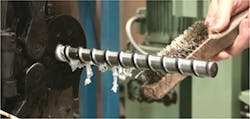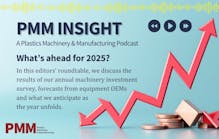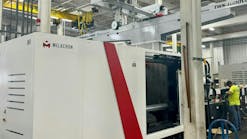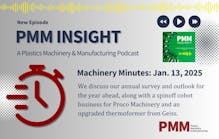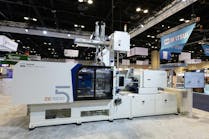Special Report: Being proactive with purging compounds prevents hazards
Whether in extrusion, injection or blow molding machines, the screw and barrel are integral components that need to be well-maintained to guard against carbon and color contamination of parts. Incorporating purging compounds into a preventive maintenance program can keep layers of carbon from building up, reduce the potential of cross-contamination of resins or colors, and lessen or eliminate the need to pull the screw out for cleaning.
Kathleen Jarvis, national sales director, Neutrex Inc., Houston, noted even reactive use of the compounds can dramatically improve the production process and part quality. "When mechanical or electrical problems arise resulting in contamination, such as black specks, in finished parts, a good commercial purging compound should be used to purge the machine and remove the contamination," she said. "This oftentimes is a quick solution to getting back online." Neutrex makes the Purgex line of purging compounds.
Using purging compounds proactively can save a lot of time and trouble later. That's especially true with the constant introduction of new additives, said Jeff Lewis, technical sales manager for Slide Products Inc., Wheeling, Ill.. "If it were my choice, I would suggest all purging be approached with a much more proactive procedure in place to stay ahead of more severe problems that can occur."
Despite the benefits, some plastics processors still only use purging compounds when there are problems with color or material changes. They see the compounds as an avoidable expense, said Renate Bever, export manager for Ultra System SA, Martigny, Switzerland, maker of Ultra Plast. "Both cases do not correspond to the reality," she said. "On the contrary, if a good purging compound is used properly and regularly, it will help to avoid a lot of problems."
Nancy Mitchell, Dyna-Purge senior technical product manager, said purging compound users may need to rethink how they use the products to get the most benefit. "All too often, purge products are not used properly or in the most cost-effective manner," she said. "Avoiding the most common problems associated with purging can be accomplished by implementing a purging program. There are three key components to a successful purging program: selecting the proper purge product, implementing the best procedure and measuring and tracking results."
If preventive maintenance is not conducted regularly, the only option is to pull the screw, clean it and then begin a maintenance program, said Eric Procunier, product development manager for Sun Plastech Inc., Parsippany, N.J., which manufactures Asaclean.
The resin and the manufacturing process will determine what purging compound is needed and how often it should be used. For example, preventive maintenance is of particular importance for processors who work with heat-sensitive resins, said Andrew Reeder, sales manager for Moulds Plus International USA, Santa Ana, Calif., which makes the Ultra Purge line of compounds. Over time, those resins degrade, causing carbon buildup and black specks.
"Setting up a preventive maintenance program is not black and white; there is some trial and error," Reeder added. "You have to find the right frequency to keep the machine clean." This may mean purging once a day, once a week, or once a month. Essentially, he said, "You're dealing with the problem before it becomes a problem."
Ultra System's Bever said the benefits of purging become apparent when running subsequent batches of resins. "It is extremely important to use a good purging compound in preventive maintenance, as it helps in keeping the metal surfaces where the plastics flow clean and smooth, so that the following plastic material can flow smoothly over the surface without sticking to an already existing layer of burnt material and masterbatch."
Frequency
Determining frequency can be a fine line. You don't want to purge more than necessary and incur extra cost, but if there is too much time between purges, buildup can become too great and necessitate pulling the screw, Reeder said. So he advises plastics manufacturers to begin by purging once a week, then back off or increase frequency from there.
Brian Cochran, technical manager for iD Additives Inc., La Grange, Ill., sees the weekend as the ideal time for preventive maintenance. "Customers specifically use our mechanical product every Friday to completely purge their machines," he said. Purging can also be conducted more frequently, if needed.
How do you know if you're letting too much time go by? "The key indicator is that it starts showing up in the parts," Reeder said. If you are scrapping too many parts because of contamination, you need to increase the frequency of your purging.
That said, in contrast to what one may think, seeing a purging compound customer increase the normal order isn't always a good thing for the seller, said Tim Cutler, business manager for Dyna-Purge, division of Shuman Plastics Inc., Depew, N.Y. "When a customer starts ordering more, that's when we start to worry, because it's usually because they are chasing a bigger problem — and adding more purging compound won't help." Additionally, this not only increases the customer's cost, it damages the buyer-seller relationship because the plant is using high amounts of product without results.
Frequency will also vary because every machine in the plastics industry is different, said Cochran. Even two machines that have serial numbers varying by just one digit can process differently, have different wear and experience different issues. This is particularly true if they're running different materials. You can have two machines that are the same, but the one running PVC will have more buildup than one running PC, he said. Thus, preventive maintenance plans for the machines need to be adapted to each to avoid using too much or too little purging compound or causing excessive downtime.
SIDEBAR: Special Report: Purging Products
An efficient time for purging is a mold changeover, said Neutrex's Jarvis. She advised, "beginning the purge at the end of the run and leaving Purgex in the barrel to 'soak' during the mold change." Once the changeover is complete, Jarvis said operators can use resin for the next run to displace Purgex. This approach minimizes downtime, while helping to prepare the machine to make quality parts in the next run. "When machine time is sold," she said, "every minute of downtime translates to lost profit."
Plastics manufacturers run their operations in different ways according to what they believe best suits their machinery, processes and products; the same holds true for their use of purging compound. As such, while the purge provider will make recommendations, Cochran said, "It's not our job to change the customer's philosophy; it's our job to address their philosophy." For that very reason, he said, it is important for the plastics processor and purging compound provider to be in communication, and for the provider to be honest with the customer. "If they are saying, 'Nothing works,' it tells me that the issue isn't the purging compound, it's a different issue, and we need to find that issue," he said. It may be that the screw needs to be pulled. "If you don't take it out after running for a long period, you can get a 'doughnut' wrapped all the way around the screw. No matter how good the purging product is, it won't get that off.
"That is all the more reason you need to use preventive maintenance," he said. "Preventive maintenance is the key to eliminating those issues. It's like an oil change for a car. You don't have to get a new car, you just have to flush the oil."
Customized formulations
While many purging-compound manufacturers will formulate a custom product for unique situations of sufficient volume, most offer a wide enough range of standard products and grades to meet the needs of extrusion, injection molding, blow molding and compounding machines, as well as a variety of temperatures and materials.
When custom formulations are developed, most suppliers add the new formulations to their product line, either immediately or after a contracted period. For example, Ultra System has developed customized products for specific problems, such as particular pigments in masterbatches, Bever said. The products were initially developed for a specific customer with an exclusive agreement of 12 to 18 months, after which Ultra System added the product to its regular line.
The compounds
Purging compounds come in various grades for different resins. They may be mechanical or chemical, and ready-to-use or concentrated.
As would be expected, the key advantage of ready-to-use products is their ease of use. "Every place we go into, simplicity is the word of the day," Cutler said. If a plant has three shifts of five workers each, that's 15 people who may be using the product. Unless the company has a very good system, with so many people using a concentrate, the plant can experience varying results, he said.
On the other hand, said Reeder, a concentrate can be very cost-effective, as it is cheaper to ship than a ready-to-use compound. Also, with a concentrate, in-house resin can be used as the carrier. For blown-film processes, using the in-house resin can enable it to maintain the needed blow-up ratio (BUR).
Having purchased Novachem last year, Asaclean maker Sun Plastech now provides both mechanical and chemical options, but, Procunier said, "You want to use mechanical purge until you are given a reason not to because [most] chemical purges require downtime." However, chemical purges do have a place, particularly for complex extrusion dies that are low-flow and low-pressure, and for hot-runner systems that have dead spots. The specifics of the customer's process will determine the best purging compound. But whether a mechanical or chemical product is used, "What's critical to both is a process of containment and pressure," he said.
Commercial Compoundsvs. In-house Resin
It is easy to see that there are many different purging compounds from many different manufacturers that can be used in preventive maintenance programs. But it is not these commercial compounds that are the manufacturers' greatest competition, Cutler said. "Our biggest competition is still that mentality that I can use in-house materials," he said.
Procunier expressed similar sentiments. While plastics processors may view next-resin purging as less expensive, he said that commercial purging compounds are more cost-effective than simply running new product through the machine until the old product is purged. In-house resin purging is generally a very slow process with the purging resin just layering over previous layers of contaminants.
But no matter what compound, frequency or process you use, the critical point is to have a preventive maintenance program. "Take the 10 to 15 minutes a week or over the weekend to keep carbon from forming in the first place," Procunier said. "Life just gets a lot easier if you're preventive purging."
Lisa Jo Lupo, correspondent
Contact:
Dyna-Purge division of Shuman Plastics Inc., 716-685-2121, www.dynapurge.com
iD Additives Inc., 708-588-0081, www.idadditives.com
Moulds Plus International USA, 714-708-2663, www.ultrapurge.com
Neutrex Inc., 800-803-6242, www.purgexonline.com
Slide Products Inc., 847-541-7220, www.slideproducts.com
Sun Plastech Inc., 800-787-4348, www.asaclean.com
Ultra System SA, 41-27722-6271, www.ultrasystem.ch
